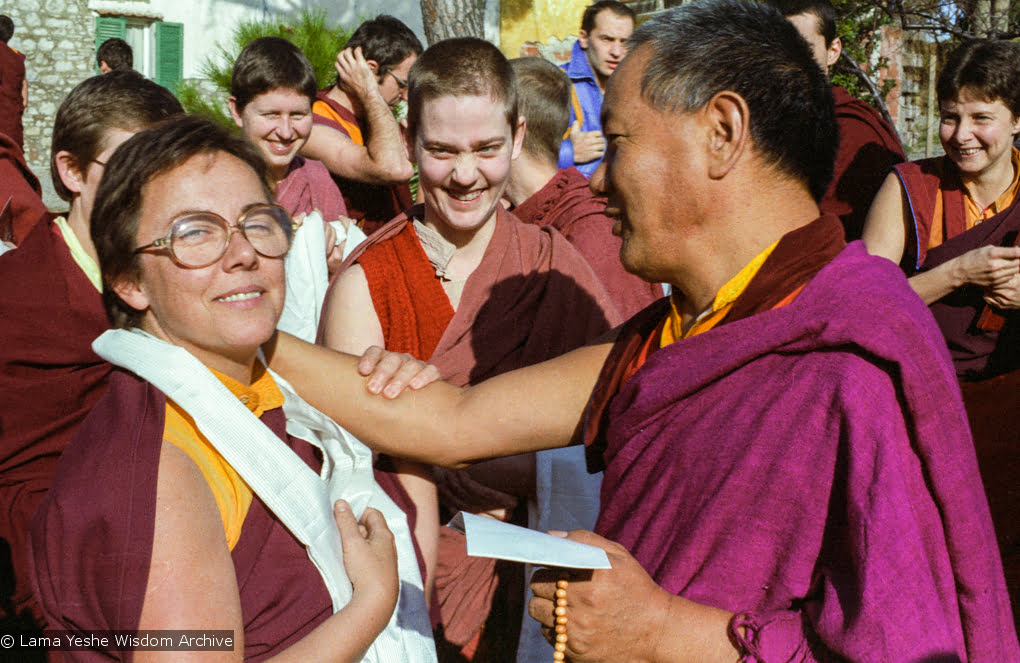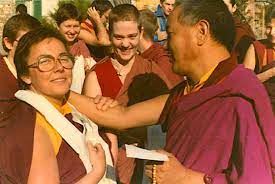
Monks and Nuns are at the Heart of the FPMT
By Ven Robina Courtin
 Lama Yeshe with Ven. Robina Courtin, and, from left, Ven. Karin Valham, Merry Colony, Ven. Connie Miller and Ven. Yeshe Khadro, Istituto Lama Tzong Khapa, 1983, the last time Robina saw Lama. Photo Jacie Keeley.
Lama Yeshe with Ven. Robina Courtin, and, from left, Ven. Karin Valham, Merry Colony, Ven. Connie Miller and Ven. Yeshe Khadro, Istituto Lama Tzong Khapa, 1983, the last time Robina saw Lama. Photo Jacie Keeley. It was forty years ago, in December 1973, at Kopan Monastery in Nepal, that Lama Yeshe established the International Mahayana Institute, the FPMT organization of monks and nuns.
Since then, they have been central to the success of the FPMT. There are now some 250 non-Tibetan IMI sangha, and in every country touched by our lamas, you will find them.
They are in lifelong meditation retreat, running centers and projects, teaching, studying to qualify as geshes, living in fasting retreats, serving the lamas, transcribing and editing and translating the teachings, building monasteries and Dharma centers, working as therapists, taking care of the dying, helping people in prison, serving as Tibetan interpreters.
There were fifty Western sangha ahead of me when I took my first vows as a nun in February 1978, at Kopan Monastery. Some of them lived at Kopan, forming the community of the International Mahayana Institute, which Lama Yeshe had named more than four years earlier.
I was delighted to become part of this group. It was eighteen months before that, at Chenrezig Institute in Queensland, at my introduction to Buddhism – one of Lama Zopa Rinpoche’s intensive one-month lam-rim courses – that I first laid eyes on a Buddhist nun, Australian Ven. Yeshe Khadro, one of a group of ten ordained in 1974 – and I was impressed. I had wanted to be a nun from the time I was a little girl, and finally the time had come.
Actually, I had wanted to be a priest and announced my decision after Mass one day. My mother’s explanation for why it wasn’t possible was beyond my grasp. “But you can become a nun,” she said.
My first efforts were thwarted at the age of 12. There I was, on my knees and with hands folded in prayer, imploring my mother to let me become a Carmelite like my hero St. Therese of Lisieux, who took vows when she was 14. Oh how I yearned to suffer for God, just like she had! And how I cried when my mother said no.
Twenty years later, she cried when I announced that I was to become a Buddhist nun. (My darling mother, as always, eventually came round to my way of thinking.)
I had come to Kopan for the November course in 1977 and it wasn’t long before I asked Lama for ordination. It was at three in the morning of Tibetan New Year that Lama sent me off to Rinpoche to receive my rabjung vows. The scissors for the symbolic cutting of a lock of my hair didn’t work properly, I remember. But my main memory is of Rinpoche saying “I just did a little drawing for you” as he carefully tore from his pad the sheet of paper with my name elegantly written in Tibetan on it, adorned by a drawing of an offering scarf and a bee taking the essence from a flower. I carried it around with me for days. I was in heaven.
THE FIRST YEARS AT KOPAN
During the first three years of the IMI, the Western sangha lived and studied together at Kopan. Ven. Roger Kunsang remembers that they “started to go to the gompa to memorize texts with the rest of the monks. But Lama Yeshe said to us, ‘You are not Tibetan! Go and do your own style!’”
And Lama told them that they needed to separate from the lay people. Ven. Yeshe Khadro says it was a bit of a shock when that happened. “They were our old friends and we’d hang out together. The idea of sangha being separate was all very new to us, but we trusted Lama.”
Nick Ribush, another of the ’74 group, remembers well Lama Yeshe’s advice at the meeting at which he established the IMI. “It was December 1973 at Kopan, and we’d just finished the Fifth November Course. Lama had given us permission to be ordained. We were preparing to go to Bodhgaya to receive Kalachakra from His Holiness and to receive our novice vows from Ling Rinpoche afterwards.”
One evening, Lama called them into his room above the gompa. “Lama was so clear about the need for sangha to live together in a community, to support each other’s ordination and Dharma practice.
“’If you’re not together, your old habits draw you towards your old objects of desire,’ Lama told us, dramatically illustrating his point as he talked by slowly moving a piece of paper towards a lit candle until it burst into flames.”
Their days were a combination of preparing for the then twice-yearly one-month lam-rim courses taught by Rinpoche, transcribing and editing teachings, and studying with one of the geshes. “One of our first teachings,” Ven. Yeshe Khadro remembers, “was The Bodhisattva’s Way of Life.”
Lama had them meeting for morning puja in the Chenrezig gompa, the original building at Kopan. “We’d do Guru Puja and take a break during it for breakfast. Two of us would be rostered on to serve the rest of the group.”
The same thing happened at lunchtime. They would do Vajrasattva puja together and take a break to eat lunch, in the gompa. Again, everyone in the group had a turn at serving the others.
“It was an interesting experience,” Ven. Yeshe Khadro remembers. “Some found it a bit difficult, but serving each other taught us to respect each other and to lessen our self-cherishing mind. For me it was similar to the experience of when I first started to do prostrations. It made you stronger but also softened your heart somehow.”
In the evenings they’d pray and make offering to Four-armed Mahakala, the deity that Lama had chosen as the protector of the IMI.
After the Sixth Course, in 1974, Lama gave the sangha and others a Vajrasattva initiation and commentary, followed by a three-month retreat, some doing it at Kopan and the rest in the mountains near Rinpoche’s cave at Lawudo in Solo Khumbu. This started the FPMT tradition of annual Vajrasattva retreats, continued to this day.
By the time I arrived, already the group was dispersing. The laws in Nepal were making it increasingly difficult for foreigners to stay, and anyway most of the Western sangha didn’t have money so were forced to leave to find work.
But mainly Lama’s burgeoning Foundation for the Preservation of the Mahayana Tradition, named in 1975, with centers being established around the world, needed good people to nurture its growth. And who better to do this than Lama’s monks and nuns?
American nun Ven. Konchog Donma was sent to Melbourne in 1977 to direct Tara House; Nick Ribush was sent to Delhi to start Tushita Meditation Centre; Ven. Yeshe Khadro was in Australia; Steve Pearl was in New Zealand helping establish Dorje Chang Institute; Ven. Ann McNeil, Ven. Sangye Khadro and Thubten Pende were in California; Ven. Elisabeth Drukier was to go to France; Ven. Roger and Marcel Bertels spent much of their time down the hill in Kathmandu, running businesses to support the IMI; and Peter Kedge traveled with the lamas on their annual worldwide teaching tours.
By the end of 1978 the Western sangha at Kopan had effectively gone. By now Lama had moved his main activities to his center in the north of England, Manjushri, including Wisdom Publications – run then by another of his monks, American Ngawang Chotak, for whom I worked – and it was here that the IMI picked up and continued to grow, spreading throughout the world.
“IT’S JUST CONDITIONS”
The very existence of the living Dharma on this earth depends upon the existence of the sangha, and for the sangha to flourish, appropriate conditions are necessary: places conducive to the maintaining and strengthening of their vows.
For Lord Buddha, the sangha is huge. He says that the existence of the Dharma in any one place is defined by the presence there of at least four fully ordained sangha.
In The Heaps of Jewels Sutra, he says: “If all the beings in the universe were to become bodhisattvas as lay people, and they each offered a butter lamp as vast as a great ocean to a stupa containing the relics of all the [past] buddhas, this would not equal even a fraction of the merit gained by a single ordained bodhisattva offering one butter lamp to the holy stupa.”
Perhaps fifty of the 250 IMI non-Tibetan monks and nuns reside at monasteries or live in retreat; the rest, given the nature of their jobs, live among laypeople.
Lama Zopa Rinpoche says, “If you don’t stay in the right environment, because the mind is weak and there are no realizations, the external objects will take over and you will follow the delusions. Then, living in ordination feels like living in a prison.”
Nick Ribush remembers it exactly like that. “I was very happy as a monk, living and working for the Dharma in India and Nepal. Then in 1983 I went to London to run Wisdom Publications. It seemed wiser to not wear my robes – and that was my biggest mistake. If people see you as a layperson, you start thinking of yourself that way.”
He struggled for a couple of years and finally decided that he’d “rather be a good layperson than a bad monk.”
“And, of course,” he adds drily, “you don’t disrobe because you want to kill somebody.”
When several years earlier Nick confessed his delusions to Rinpoche, Rinpoche replied, “It’s just conditions.”
When Nick told me that, the truth of it dawned on me. Until then, I’d arrogantly think to myself, Oh, I won’t ever not be a nun. And it was poignantly driven home on a visit to Tibet in 1987. In conversation with one of the old geshes at Ganden Monastery, a former monk, he asked me how long I’d been a nun. “Nearly ten years,” I said. “And I always pray to have the conditions to remain ordained.”
His sadness was palpable. Before 1959, even in his dreams, he would never have imagined not being a monk. What happened? Conditions changed.
First published in Mandala Magazine in 2014.
